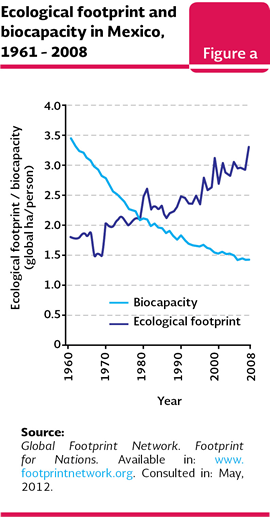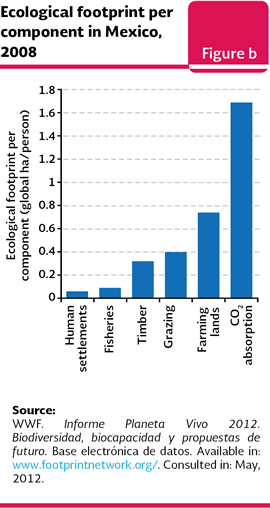The misuse of the natural resources at a worldwide level is clearly reflected in the rise of the ecological footprint of the countries, situation from which Mexico is not apart. As, in 1961, the estimated ecological footprint for our country was 1.7 global hectares per person, for 2008 it had grown until reaching a value of 3.3; in the same period, its bio capacity decreased from 3.4 to 1.42 global hectares per person (Figure a). This means that in 47 years, every Mexican went from having an ecological credit of 1.6 global hectares to a deficit of 1.9 global hectares (in other words, 0.5 global hectares more than the ones that corresponded to every inhabitant in 2008).

From the components of the national ecological footprint, the surface which has had the highest increase is the one required to absorb the CO2 produced by the fossil fuel burning: while in 1961 it was 0.07 global hectares per person, in 2008 it was increased to 1.7 global hectares per individual, which means 51.5% of the ecological footprint of an average Mexican (3.3 global hectares per person; Figure b).

As of today, it has not been calculated the ecological footprint of all of the Mexican cities, but it is expected that it is also big. Some of them which have an evaluation of this type are Xalapa, in Veracruz, whose ecological footprint per inhabitant was calculated in 2.9 global hectares; in Jalisco, the average ecological footprint of the urban areas of Cabo Corrientes, Tomatlán and Puerto Vallarta was calculated in 2.75, with an ecological deficit of 0.80 global hectares per person. For the case of the rural areas of this state, the ecological footprint per person was calculated in 2.38 global hectares, with a 0.38 deficit. The same study detected differences between the ecological footprints of the visitors to Puerto Vallarta: for the national tourists, the ecological footprint was 4.36 (with a 3.56 ecological deficit) and for the foreign visitors was 11.29 (with a deficit of 9.49 global hectares per individual).
REFERENCES:
Chávez-Dagostino, R.S., J.L. Cifuentes-Lemus, E., Andrade-Romo, R. Espinoza-Sánchez, B.M. Massam y J. Everitt. Huellas ecológicas y sustentabilidad en la costa norte de Jalisco, México. Teoría y Praxis 5: 137-144. 2008. Disponible en: www.teoriaypraxis.uqroo.mx.
Global Footprint Network. Footprint for nations. México 1961-2008. Disponible en: www.footprintnetwork.org/en/index.php/GFN/page/footprint_for_nations/. Fecha de consulta: mayo de 2012.
Nieto Caraveo, L.M. La huella ecológica. ¿Qué tantos recursos naturales tenemos? ¿Qué tantos recursos naturales usamos? Disponible en: http://ambiental.uaslp.mx/docs/LMNC-AP990325.pdf. Fecha de consulta: mayo de 2012.
WWF. Informe Planeta Vivo 2012. Biodiversidad, biocapacidad y propuestas de futuro. Base electrónica de datos. Disponible en: www.footprintnetwork.org. Fecha de consulta: mayo de 2012. |